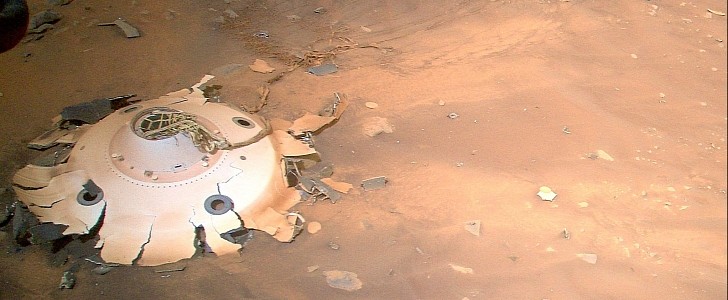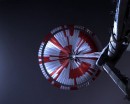Last year in February, NASA's Perseverance rover arrived on Mars along with a little helicopter hidden in its belly called Ingenuity. The duo safely touched down thanks to a cone-shaped backshell and a parachute, which remained scattered on the Martian surface. Recently, Ingenuity completed its 26th flight on the Red Planet, capturing during its trip the dusty landing gear.
Ingenuity took to the skies on April 19, exactly one year after it conducted its first flight on Mars. The helicopter stayed in the air for 159 seconds. It climbed to a 26-ft (8-meter) altitude and traveled 630 ft (192 meters) until it caught a glimpse of a familiar sight.
There it was – the dusty landing gear that helped the two robotic partners safely land on Mars. The Perseverance's backshell looks like it held up well after dealing with gravitational forces and extreme temperatures that occur with entering the atmosphere at roughly 12,500 mph (20,000 kph).
The landing gear was captured at the beginning of the month by Perseverance. But since the rover was further away, you have to really focus to see the supersonic parachute and backshell.
Inegenuity's images are taken from a closer distance, and they offer more details. These pictures can help scientists better prepare for future landings that will be performed by spacecraft as part of the Mars Sample Return mission (which will involve several robotic systems that will work together to bring samples collected by Perseverance back to Earth for analysis).
"But Ingenuity's images offer a different vantage point. If they either reinforce that our systems worked as we think they worked or provide even one dataset of engineering information we can use for Mars Sample Return planning, it will be amazing. And if not, the pictures are still phenomenal and inspiring," said Ian Clark, former Perseverance systems engineer and now Mars Sample Return ascent phase lead.
The shots taken of the backshell suggest that the protective coating survived the fiery atmospheric entry. Moreover, several high-strength suspension lines linking the backshell to the parachute also seem to be in good shape. And speaking of the parachute, although dusty, the canopy appears to be in good condition as well. Scientists will need a few more weeks to analyze the photographs before reaching any conclusions.
There it was – the dusty landing gear that helped the two robotic partners safely land on Mars. The Perseverance's backshell looks like it held up well after dealing with gravitational forces and extreme temperatures that occur with entering the atmosphere at roughly 12,500 mph (20,000 kph).
The landing gear was captured at the beginning of the month by Perseverance. But since the rover was further away, you have to really focus to see the supersonic parachute and backshell.
Inegenuity's images are taken from a closer distance, and they offer more details. These pictures can help scientists better prepare for future landings that will be performed by spacecraft as part of the Mars Sample Return mission (which will involve several robotic systems that will work together to bring samples collected by Perseverance back to Earth for analysis).
"But Ingenuity's images offer a different vantage point. If they either reinforce that our systems worked as we think they worked or provide even one dataset of engineering information we can use for Mars Sample Return planning, it will be amazing. And if not, the pictures are still phenomenal and inspiring," said Ian Clark, former Perseverance systems engineer and now Mars Sample Return ascent phase lead.
The shots taken of the backshell suggest that the protective coating survived the fiery atmospheric entry. Moreover, several high-strength suspension lines linking the backshell to the parachute also seem to be in good shape. And speaking of the parachute, although dusty, the canopy appears to be in good condition as well. Scientists will need a few more weeks to analyze the photographs before reaching any conclusions.





